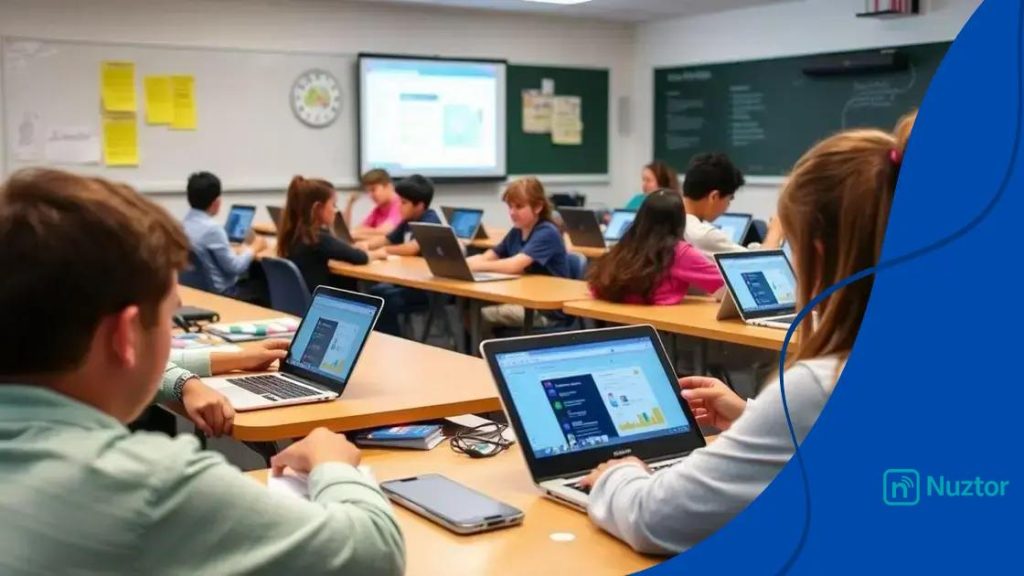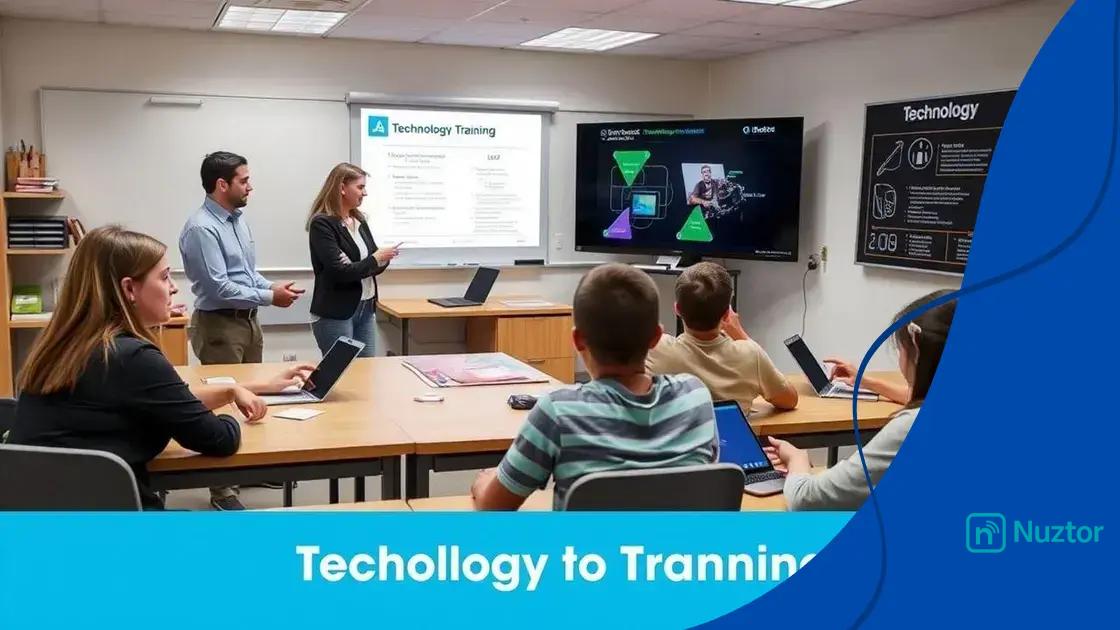Tech adoption in schools: transforming education today

Tech adoption in schools enhances learning through personalized AI, immersive VR experiences, and a focus on social-emotional learning, addressing modern educational challenges effectively.
Tech adoption in schools isn’t just a trend; it’s a transformation of how students learn and engage. Have you noticed how tech-savvy the latest generation is? This article explores its impact.
The importance of digital literacy in education
Digital literacy is crucial in today’s education landscape. It empowers students with the skills they need to navigate the online world effectively and safely. In a technology-driven society, understanding how to use digital tools is essential.
Why Digital Literacy Matters
Having strong digital literacy skills opens doors for students. They can access information quickly, communicate effectively, and collaborate with peers using technology. This competency also enhances their research abilities, helping them find credible sources.
Furthermore, educators play a vital role in fostering these skills. By integrating technology into lessons, teachers can create engaging learning environments that stimulate interest and participation. For example, students can use online platforms to work on group projects or explore interactive educational resources.
Key Benefits of Digital Literacy
- Enhances critical thinking and problem-solving skills.
- Prepares students for future careers that require tech proficiency.
- Encourages creativity in expressing ideas through various digital mediums.
- Fosters responsible online behavior and digital citizenship.
By equipping students with these necessary skills, we are preparing them for lifelong learning and success. Digital literacy helps ensure they can thrive in a world that increasingly relies on technology.
How technology enhances student engagement
Technology plays a significant role in enhancing student engagement. When used effectively, it can transform classrooms into interactive and dynamic learning environments. Students often feel more motivated and excited to learn when they can explore topics through various digital platforms.
Interactive Learning Tools
One way technology boosts engagement is through the use of interactive learning tools. For instance, educational apps and online games make lessons enjoyable and help students grasp complex concepts more easily. By integrating gamification, teachers can encourage participation and foster competitive spirit among students.
- Digital quizzes that provide instant feedback.
- Interactive simulations that mimic real-world scenarios.
- Collaborative projects using cloud-based platforms.
- Fun challenges that enhance critical thinking.
Additionally, technology allows for personalized learning experiences. Students can learn at their own pace and revisit material that challenges them. This individualized approach helps address diverse learning styles and needs. For example, some students may thrive with visual aids, while others prefer hands-on tasks or auditory resources.
Real-World Connections
Moreover, technology fosters connections between students and the real world. With resources like virtual field trips or video conferencing with experts, learners can explore beyond traditional textbooks. These experiences bring lessons to life and help students understand the relevance of their education.
By integrating technology in lessons, educators can spark curiosity and promote deeper learning. When students are engaged, they are more likely to take ownership of their education. This engagement not only boosts retention rates but also cultivates a love for learning that can last a lifetime.
Challenges of implementing technology in classrooms

Implementing technology in classrooms comes with various challenges that educators must navigate. While the benefits are significant, schools often face obstacles that can slow down the integration of digital tools.
Infrastructure and Resource Limitations
One major challenge is inadequate infrastructure. Many schools struggle with outdated equipment and slow internet connections. Without a solid technological foundation, it is difficult for teachers to implement new tools effectively. Providing sufficient devices for all students is also a concern; sharing gadgets can hinder learning experiences.
- Inconsistent access to technology for students.
- High costs of upgrading digital resources.
- Lack of technical support for troubleshooting.
- Limited availability of space for technology integration.
Another issue is the training required for educators. Teachers need guidance on how to use technology in their classrooms. Professional development is crucial, but many educators report that they do not receive enough training or support to feel confident with new tools. This gap in skills can lead to a lack of effective implementation and resistance to change.
Resistance to Change
Additionally, some teachers may be hesitant to adopt technology. They might feel overwhelmed or doubt their ability to keep up with new tools. This resistance can create a barrier not just for individual educators but also for the entire school culture. Encouraging a mindset shift is essential for overcoming this reluctance and promoting a more tech-friendly approach.
Moreover, parental involvement is important in this equation. Schools must communicate effectively with families about the benefits and purposes of technology in education. Engaging parents can help alleviate fears and build support for tech initiatives. Involving the community ensures a unified approach to enhancing student learning experiences.
Successful case studies of tech adoption
Successful case studies of tech adoption in schools provide valuable insights into how technology can enhance education. Many schools across the globe have implemented innovative tech tools that not only improve learning outcomes but also engage students in meaningful ways.
The flipped classroom model
One example is the flipped classroom model, which has gained popularity in recent years. In this approach, students learn new content at home through videos and online resources. Then, class time is used for hands-on activities and discussions. This method allows students to learn at their own pace and come prepared with questions.
- Increased student participation in discussions.
- More time for personalized support from teachers.
- Greater student ownership of learning.
- Enhanced collaboration among peers.
Another noteworthy example is the use of gamification in education. Schools that have incorporated game-based learning report significant increases in student motivation and engagement. By using educational games, teachers can make complex subjects more approachable and fun.
Blended learning environments
Blended learning environments combine traditional teaching methods with online learning. This flexible approach caters to different learning styles and encourages critical thinking. For instance, a local high school adopted blended learning and saw improved test scores across various subjects.
Administrators noted that students appreciated the combination of in-person and online instruction. It allowed learners to explore topics in depth while benefiting from direct interaction with teachers. As a result, students felt more supported and engaged in their learning journey.
These case studies highlight the importance of embracing technology in education. When implemented thoughtfully, tech adoption creates enriched learning experiences that prepare students for the future.
Future trends in educational technology
Future trends in educational technology are shaping how teachers and students interact in the classroom. As technology evolves, so do the methods used to enhance learning experiences. Schools are increasingly looking toward innovative solutions that can engage students more effectively.
Artificial Intelligence in Education
One major trend is the integration of artificial intelligence (AI) in educational settings. AI can personalize learning pathways for students by adapting lessons to their individual needs. This means that each student receives customized support, enabling them to progress at their own pace.
- AI-driven tutoring systems provide instant feedback.
- Chatbots assist students with homework questions after school hours.
- Data analytics help teachers identify struggling students early.
- AI tools can suggest resources based on student performance.
Moreover, the rise of virtual and augmented reality is changing how content is delivered. With VR and AR technologies, students can experience immersive learning environments. For instance, history students can take virtual field trips to historical sites, making lessons more engaging.
Focus on Social-Emotional Learning
Another important trend is a growing focus on social-emotional learning (SEL). Schools are beginning to recognize that emotional intelligence is just as vital as academic skills. Technology can aid SEL by providing platforms that encourage social interaction and empathy through collaborative projects.
For example, apps that foster communication and teamwork help students build strong relationships. Interactive tools can create safe spaces for dialogues about feelings and personal experiences.
As these trends continue to evolve, we can expect educational technology to further innovate and adapt to the needs of modern learners. The future is bright, with endless possibilities for making education more accessible, engaging, and effective.
FAQ – Frequently Asked Questions about Technology Adoption in Schools
What is the significance of AI in education?
AI plays a key role in personalizing learning, allowing for tailored educational experiences that fit individual student needs.
How can virtual reality (VR) enhance classroom learning?
VR provides immersive experiences that make learning more engaging, allowing students to explore complex topics in a realistic environment.
What is social-emotional learning (SEL) and why is it important?
SEL focuses on developing emotional intelligence, helping students manage emotions, set goals, and establish positive relationships.
What challenges do schools face when adopting new technology?
Schools often struggle with infrastructure issues, teacher training, and resistance to change, which can hinder effective technology integration.